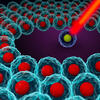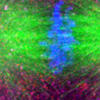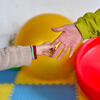You are here
Space experiments aboard the ISS

1. Human metabolism in microgravity
Time spent in space is a major strain on the bodies of astronauts. “In conditions of microgravity, no longer need muscles to stand, which leads in particular to muscular atrophy,” explains Audrey Bergouignan of the Hubert Curien Pluri-disciplinary Institute (IPHC)1. More specifically, the researcher and her team are studying the metabolic changes caused by microgravity, which can lead to disorders similar to those observed among people suffering from metabolic diseases, such as type 2 diabetes.

Between 2011 and 2017, Bergouignan and her colleagues measured the total energy expenditure among 11 members of the International Space Station (ISS), including Thomas Pesquet. “We used the doubly labelled water method, for which the astronauts drank water containing stable isotopes such as deuterium and oxygen-18. The more energy is spent, the more these tracers are eliminated from the body. By measuring how quickly they disappeared in urine, we inferred daily energy expenditure.” The subjects of our study were also equipped with accelerometers to collect data on their daily physical activities.
“Our results revealed that weight regulation mechanisms become inoperative in space. The astronauts are unable to maintain a stable mass.” In order to keep them in good health, the scientist therefore recommends more personalised monitoring in orbit.
2. Plants in a hostile environment
Microgravity, radiation, the lack of gas convection that prevents air renewal. “In orbit, plants are exposed to factors never encountered during their evolution,” points out Eugénie Carnero-Diaz from the ISYEB2. “It takes two years to go to Mars and back. It is therefore necessary to ensure that plants are capable of fulfilling their roles, such as water or air purification, or nutrition.”

The scientist and her team sent thale cress plants (Arabidopsis thaliana) to the ISS as part of the GENERA-A project. “We observed that microgravity indeed acts as a stress factor on these organisms. This was especially true of radiation, which is very harmful for proteins.” Another experiment conducted between 2013 and 2017 in connection with the Seedling Growth project confirmed that the cell cycle of A. thaliana is disrupted under the effect of weightlessness, with slower mitosis and earlier cell division than on Earth.
“We believe that it is a compensatory mechanism that maintains the growth of the plant’s organs despite the hostile environment,” suggests Carnero-Diaz. “We also observed that exposure to red light helps mitigate this disruption.” It remains to be seen whether this compensation continues over the long term.
3. Organic matter put to the test by radiation
To shed light on the mystery of the origins of life on Earth, it is important to better understand the chemistry that preceded the emergence of living beings. “Some molecules brought by comets and meteorites may have contributed to the appearance of life,” reveals Hervé Cottin of the LISA laboratory of atmospheric systems3.
The scientist and his team study the evolution of organic matter under the effects of solar radiation. As part of this effort, they sent samples outside the ISS. “We observed the evolution of molecules in space, such as amino acids, which are the building blocks of proteins. Amino acids are also present in comets and certain types of meteorites. Once ejected from the comet’s nucleus, these molecules can circulate around the Sun in dust particles for tens and even hundreds of thousands of years before falling down to Earth.”

This results in the molecules degrading much quicker in space than on Earth, with kinetics “10 to 100 times faster for some of them. Under such conditions, the amino acids that are less resistant to radiation could have been destroyed well before arriving on our planet”.
In early November 2024, Cottin’s teams sent 26 new samples to the ISS. For the first time, their evolution will be studied with precision thanks to an infrared spectrometer4, which will help refine the list of ingredients that may have fallen to Earth before the appearance of life.
4. Foams destabilised by weightlessness
Foams are part of our daily lives, and are especially present in food and cosmetics. They are scrutinised by Emmanuelle Rio, a researcher at the Laboratory of Solid-State Physics (LPS)5, who studies the stability of soapy objects such as bubbles, soap films, and foams. However, she emphasizes that studying the behaviour of liquid foams on Earth is a risky exercise, as gravity renders them unstable: “On Earth, a foam’s liquid content falls between bubbles, which leads to the collapse of the whole, as well as the separation of the liquid from the gas.”
To avoid this problem, the scientists sent foamy liquids aboard the ISS as part of the Foam-Coarsening (FOAM-C) experiment, and observed them using both a camera and a laser, which provides accurate information regarding the foam’s liquid content, in addition to the size of the bubbles. And they noted that “small bubbles accumulate over time, getting increasingly numerous, as they are so small that they have no contact with neighbouring ones, and thus stop ageing. These bubbles no longer form part of the foam, and become independent”.
While all of the data gathered in space has not yet been analysed, the scientists hope to soon have a better grasp of the properties of foams. For the time being their formulation is based on a few general principles, for lack of more precise knowledge, but with continued research the foams of the future could indeed become more stable and effective. ♦
For further reading
Can humans withstand long spaceflights?
Investigating the origins of life
- 1. CNRS / Université de Strasbourg.
- 2. Institut de Systématique, Évolution, Biodiversité (CNRS / EPHE / MNHN / Sorbonne Université).
- 3. Laboratoire Interuniversitaire des Systèmes Atmosphériques (CNRS / Université Paris Cité / Université Paris-Est Créteil Val-de-Marne).
- 4. https://u-paris.fr/un-laboratoire-dastrochimie-et-dexobiologie-de-nouvel(link is external)...(in French)
- 5. CNRS / Université Paris-Saclay.















